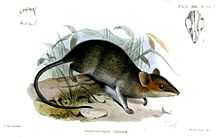Red-cheeked dunnart
| Red-cheeked dunnart[1] | |
|---|---|
 | |
| Conservation status | |
| Scientific classification | |
| Kingdom: | Animalia |
| Phylum: | Chordata |
| Class: | Mammalia |
| Infraclass: | Marsupialia |
| Order: | Dasyuromorphia |
| Family: | Dasyuridae |
| Genus: | Sminthopsis |
| Species: | S. virginiae |
| Binomial name | |
| Sminthopsis virginiae (de Tarragon, 1847) | |
 | |
| Red-cheeked dunnart range | |
| Synonyms | |
|
Phascologale virginiae | |
The red-cheeked dunnart (Sminthopsis virginiae) is so called because of the distinctive red hair on its cheek. It is an Australasian marsupial. Its total length is 167–270 mm; its average body length is 80–135 mm with a tail of 87–135 mm. Ear length is 12–13 mm. Its weight varies between 18 and 75 grams. Its tail is thin and pale pink.
Distribution and habitat
The red-cheeked dunnart is distributed in Australia and New Guinea. The nominate subspecies S. v. virginiae occurs in the Queensland around the North Gulf, NE coasts, Mackay to Cape York. Subspecies S. v. nitela inhabits the Kimberley's to the top of Northern Territory. Habitat includes woodlands, open rocky forests, savannah grasslands, swamps, soaks and margins of tropical forests.
Social organisation and breeding
The behaviour of the red-cheecked dunnart, like most Sminthopsis species, is not well known. They breed from October to March. Young are gestated for 15 days and weaned at 65–70 days with maturity by 4–6 months.
Diet
Its typical diet includes mainly small reptiles.
Subspecies
There are three recognised subspecies of the red-cheeked dunnart:[1]
- S. v. virginiae, found in Australia
- S. v. nitela, found in Australia
- S. v. rufigenis, found in New Guinea
References
- ↑ 1.0 1.1 Groves, C. P. (2005). Wilson, D. E.; Reeder, D. M, eds. Mammal Species of the World (3rd ed.). Baltimore: Johns Hopkins University Press. p. 36. OCLC 62265494. ISBN 0-801-88221-4.
- ↑ Helgen, K., Dickman, C., Lunde, D., Burnett, S., Woinarski, J. & Woolley, P. (2008). Sminthopsis virginiae. In: IUCN 2008. IUCN Red List of Threatened Species. Retrieved 28 December 2008. Database entry includes justification for why this species is of least concern
- Menkhorst, P.; Knight, F. (2001). A field Guide to the Mammals of Australia. Oxford Press. ISBN 0-19-550870-X.
